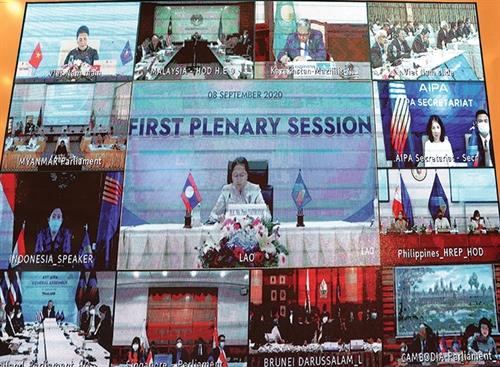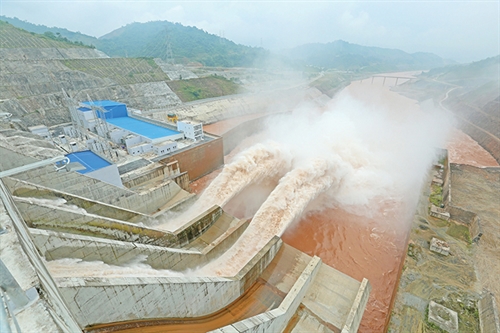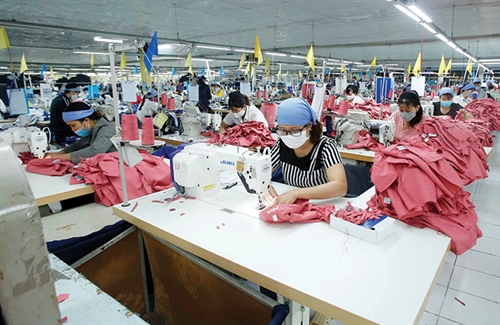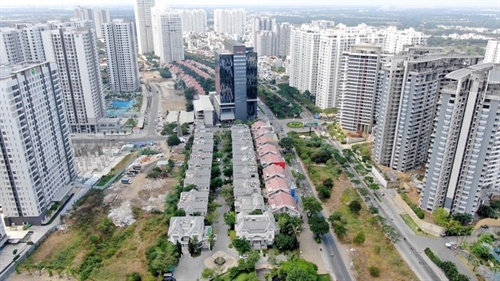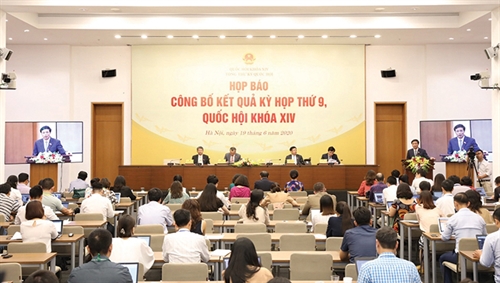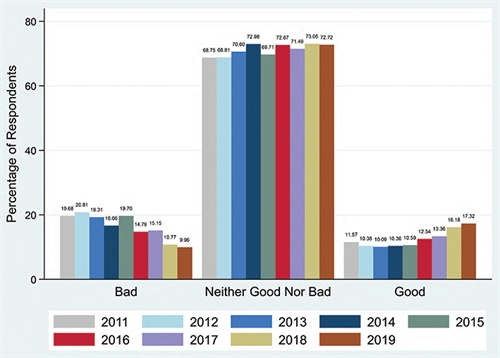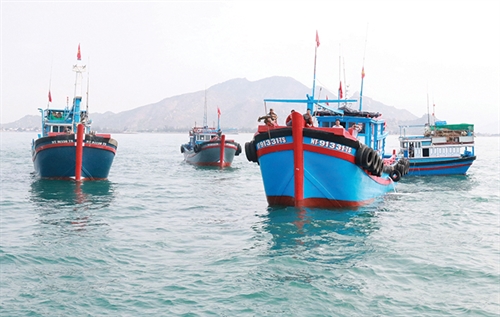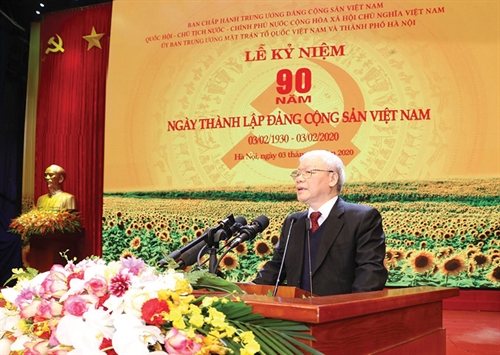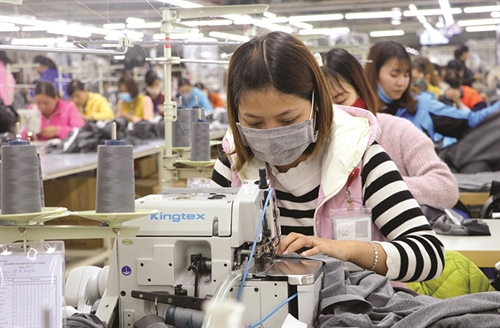Stepping into a new decade of the 21st century, along with economic opportunities, Vietnam has to face numerous challenges, including environmental pollution and degradation. This article reviews the country’s environmental protection work over the past years and proposes some recommendations in the upcoming time.
Nguyen Trung Thang, Hoang Hong Hanh, Vu Thi Thanh Nga, and Nguyen Ngoc Tu
Institute of Strategy and Policy on Natural Resources and Environment
In recent years, against the backdrop of the escalation of trade wars among developed countries and Industry 4.0, Vietnam’s economy has made remarkable achievements, with the year-on-year growth rate of nearly 7 percent. According to the Organization for Economic Cooperation and Development (OECD)’s 2019 report on multi-dimensional review of Vietnam, by 2035, the middle class will account for about 50 percent of the country’s population as people’s material and spiritual lives have been more and more improved.
However, climate change, exhaustion of natural resources, and environmental pollution, among many other environmental problems, are still posing challenges to the country.
To cope with the circumstances, the Party and the State have determined to achieve the United Nations’ 17 Sustainable Development Goals by 2030, and implement the Paris Agreement on Climate Change adopted at the Paris Climate Conference (COP21) in 2015, by striving to pursue rapid and sustainable development policies, one of which is a strategy for environmental protection for the next 10 years.
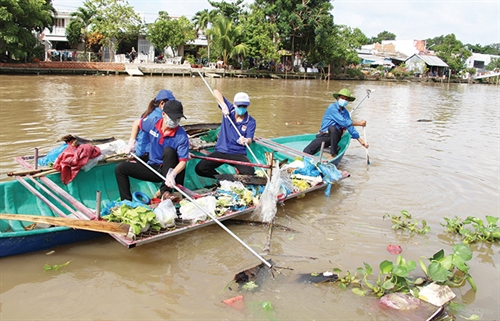 |
| Collecting rubbish from canals in Hau Giang province__Photo: Hong Thai/VNA |
Current situation of the environmental protection work
Achievements
Since the adoption of the Strategy for environmental protection through 2020, with a vision toward 2030, by the Prime Minister in 2012, positive changes have been seen in environmental protection work. People’s awareness has been considerably raised while the legal system on environmental protection has been improved in light of the Government’s principle of not trading environmental health for economic growth.
According to the Ministry of Finance’s statistics, total budget expenditures for environmental protection was increased to more than VND 20 trillion in 2019 from some VND 9 trillion in 2013[1]. Meanwhile, during 2012-18, nearly USD 7 billion was mobilized from international cooperation for environmental protection and climate change adaptation activities[2].
Regarding prevention and control of environmental pollution, by 2018, more than 92 percent of seriously polluting establishments were thoroughly handled, 75 percent of hazardous wastes and 98 percent of medical wastes were properly collected, sorted and disposed of. By 2019, 89 percent of industrial parks and export processing zones had wastewater treatment systems and over 86 percent of municipal solid wastes were collected[3].
The situation of environmental hygiene in rural areas has also been improved. By 2018, around 65 percent of communes achieved environment and food safety standards set under the national target program on building a new-style countryside; more than 88 percent of communes had sanitary toilets, a remarkable increase from the rate of 52 percent in 2010; 86 percent of urban residents were supplied with clean water while nearly 95 percent of rural inhabitants had access to hygienic water[4].
Regarding sustainable exploitation and use of natural resources, nature and biodiversity conservation, in 2018, the country’s forest coverage increased to nearly 42 percent while violations of the law on forest protection and development decreased over the previous period’s data[5]. Compared to 2015’s figures, by 2019, the country had three more terrestrial nature reserves with a total area of about 2,500 hectares and four more marine nature reserves covering around 0.11 percent of the sea areas nationwide[6].
In order to better prevent and control natural disasters, efforts have been concentrated on improving Vietnam’s capacity of responding to climate change. Climate change and sea level rise response scenarios had been updated twice in 2012 and 2016 while progress was seen in hydrometeorological forecasting[7].
In the field of energy, Vietnam has managed to reduce the energy consumption volume by 5.65 percent during 2011-15. The country’s solar generation capacity increased to 4.5GM in 2019 and a lot of activities have been carried out with a view to reducing greenhouse gas emission[8].
Limitations and shortcomings
Despite the country’s great efforts, environmental pollution and degradation still continue to become worse. Air pollution gets serious in big urban centers such as Hanoi and Ho Chi Minh City at certain time of the year. More than 80 percent of industrial complexes have not yet had wastewater treatment systems, while 87 percent of municipal domestic wastewater is not property treated. Domestic solid waste is not sorted at source; waste recycling rate remains low, just 8-12 percent; the disposal of waste to landfills in urban areas is 70 percent of generated amount while nearly 37 percent of rural domestic solid waste is not properly collected and disposed.
Several environmental pollution incidents occurred during 2012-19. The case of Formosa Ha Tinh in 2016 and contaminated tap water crisis of Da river water plant in Hanoi in 2019 could be cited as typical examples.
Due to unsustainable exploitation and inefficient use of natural resources, biodiversity continues to degrade. Despite forest coverage expansion, forest quality still declines as a result of forest fires and illegal loggings. Important natural ecosystems such as seagrass beds and coral reefs are further degrading, wildlife loss still occurs and the risks of invasive species and genetically modified organisms remain in existence.
The effectiveness of water security work is below expectation, leading to continued decline of groundwater and pollution of surface water. Some localities have not yet put an end to illegal mining activities. Unsustainable aquaculture practices and illegal fishing activities still occur.
Vietnam’s capacity for responding to climate change remains limited, making the country vulnerable to natural disasters. The dissemination of climate change adaption and low-carbon development models as well as application of renewable energy and waste-to-energy technologies face numerous difficulties. In 2015, the country’s primary energy intensity was 20 GI/USD GDP, much higher than the global average of 8 GI/USD GDP and those of regional countries like the Philippines, 8.4 GI/USD GDP, Indonesia, 9.6 GI/USD GDP, and Malaysia, 10.9 GI/USD GDP[9].
Policy recommendations for the next 10 years
In the next decade, in order to achieve set sustainable development goals, Vietnam needs to stop environmental pollution and degradation, and gradually improve environmental quality; prevent the degradation of biodiversity; increase climate change adaptation capacity, and boost the development of a low-carbon economy. The country therefore should focus on fulfilling several tasks.
Firstly, it is necessary to further strengthen the prevention and control of environmental pollution and degradation. In light of this, a national master plan on environmental protection should be formulated and effectively implemented while issues on natural resources and environment should be included in regional, sectoral and provincial master plans. The economy should be developed along the direction of environmental friendliness together with the formulation of models of low-carbon and circular economy. The effectiveness of strategic environmental assessment and environmental impact assessment should be improved. The country should also apply the policies of environmental licensing and classification and control of pollution sources, especially for sources with a high degree of environmental pollution risks, even trans-boundary ones, while applying measures for actively preventing and responding to environmental incidents.
Secondly, Vietnam should redress pressing environmental issues and step by step improve environmental quality, focusing on controlling and preventing pollution and raising the quality of air environment in big cities. Solid waste should be strictly managed in the direction of reducing landfill disposal combined with material and energy recovery and reduction and recycling of plastic waste. Domestic wastewater in urban centers should be basically treated while the quality of water environment should be improved. Localities should take measures to restore and improve the environment in areas contaminated with pesticides and dioxins.
Thirdly, efforts should be concentrated to prevent biodiversity loss and ensure sustainable exploitation and efficient use of natural resources. Ecosystems and natural landscapes should be further conserved, preserved and restored. Forest coverage needs too be further expanded in combination with prevention of forest degradation and protection of wildlife species, genetic resources and biosafety.
Fourthly, the country should proactively adapt itself to climate change situation. Climate change-related contents should be included in all environmental protection strategies, master plans, plans, programs, and investment projects along the line of applying ecosystem-based approaches for climate change adaptation. Greenhouse gas emission reduction measures should be implemented in association with control and minimization of air pollution, promotion of the use of clean fuels and recovery of energy from solid waste.
There are some solutions for realizing the orientations mentioned above.
The first solution is changing thinking and perception of development. In order to escape from poverty, Vietnam has concentrated all its efforts on economic growth over the past 30 years. However, economic growth is accompanied with environmental pollution and degradation which unfortunately has reached a tipping point. In the next 10 years, the country should develop its economy within the limits of ecological balance and in harmony with the nature, following the laws of nature and minimizing negative impacts on the environment. This mindset must be perceived and turned into action by every state agency, business and citizen.
The second solution requires enhancement of the enforcement of the law on environmental protection. To this end, administrative sanctions and criminal penalties applicable to environmental violations should be increased while capacity of environment management agencies at all levels should be enhanced.
The last solution is to apply a raft of synchronous measures to diversify investment resources for environmental protection. It is necessary to formulate mechanisms and policies, develop the market for environmental goods and services, promote administrative procedure reform, and enhance the publicity and transparency to attract the participation of businesses and the community in environmental protection work. Besides, investment from the state budget in environmental protection should be increased while operational efficiency of environmental protection funds should be improved. The State should also complete the legal framework and promote investment in green projects by applying the mechanism of “green” credit and “green” bond and attracting investment from international financial institutions and developed countries for environmental protection.-
